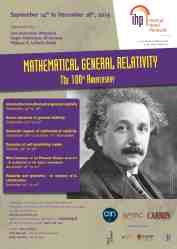_____________________________________________________________________________________________________________
Seminar at the
Laboratoire Jacques-Louis Lions
Sorbonne Université, Paris
Organizers
Philippe G. LeFloch (Sorbonne, Paris)
Jacques Smulevici (Sorbonne, Paris)
Jérémie Szeftel (Sorbonne, Paris)
Dates of the Seminar this Fall 2018
September 24, October 29, November 19
Monday September 24, 2018
room 15/16-309
14h Dietrich Häfner (Grenoble)
Scattering for Dirac and Klein-Gordon fields on the (De Sitter) Kerr metric and the Hawking effect
Abstract. We consider Dirac and Klein-Gordon fields on the (De Sitter) Kerr metric which describes rotating black holes. Whereas there exists a conserved L2 norm for the Dirac field, no positive conserved quantity exists for the Klein-Gordon field, which makes the analysis more difficult for the latter. We obtain asymptotic completeness results for the Dirac field on the Kerr and for the Klein-Gordon field on the De Sitter Kerr metric. We then present a rigorous result about the Hawking effect for fermions in the setting of a collapse of a rotating charged star. This effect predicts the creation of particles by black holes.
15h30 Jean-Philippe Nicolas (Brest)
Peeling for scalar fields on the Kerr metric
Abstract. The peeling is an asymptotic behavior of massless fields along outgoing null geodesics in asymptotically flat spacetimes, initially observed by Sachs at the beginning of the 1960’s, then reformulated in very simple terms by Penrose in 1965 using conformal geometry. The question of its genericity, especially when talking about the peeling of the Weyl tensor of an Einstein spacetime, was controversial for several decades after Penrose’s paper. For Einstein’s equations, the question is now essentially settled, but given an Einstein spacetime, it is not clear whether there is a large class of Cauchy data giving rise to solutions with a good peeling. Lionel Mason and the speaker answered the question for fields of spin 0, 1/2 and 1 on Schwarzschild’s spacetime in 2009 and 2012. We extended recently the results to linear and non linear scalar fields on the Kerr geometry in a joint work with Pham Truong Xuan. We shall recall the history of the subject, describe the principles of the approach developed with Lionel Mason and talk about the specific features of our work for Kerr metrics.
Monday October 29, 2018
room 15/16-101
14h Joe Keir (Cambridge)
The weak null condition and the p-weighted energy method
Abstract. The Einstein equations in wave coordinates are an example of a system which does not obey Klainerman’s “null condition”. Their failure to satisfy this condition leads to many difficulties, both in Lindblad-Rodnianski’s proof of global existence and in any attempt to apply other techniques to these equations. One such technique is the “p-weighted energy method” of Dafermos- Rodnianski, which is a very powerful and robust method that can easily be adapted to understand the behavior of waves in many interesting situations, including black holes. In this talk I will explain how to modify this method to systems which only obey the “weak null condition”, including the Einstein equations. This involves adapting the p-weighted energy method, and combining it with the many of the geometric methods used by Christodoulou and Klainerman. Among other things, this allows us to enlarge the class of wave equations which are known to admit small-data global solutions, and it also yields a detailed description of null infinity. In particular, in some situations we can understand the geometric origin of the slow decay towards null infinity exhibited by these systems: it is due to the formation of “shocks at infinity”.
15h30 Volker Schlue (Paris)
Scattering from infinity for semi-linear wave equations
Abstract. I will discuss the construction of global solutions from scattering data (at null infinity) for various semi-linear wave equations on Minkowski space satisfying the (weak) null condition. I will elaborate on the proof which relies, i) on a fractional Morawetz estimate, and (ii) on the construction of suitable approximate solutions from the scattering data. Finally I will outline the application of these results to Einstein’s equations in harmonic coordinates. This is joint work with Hans Lindblad.
Monday November 19, 2018
room 15/16-309
14h Adam Layne (Stockholm)
Stability within T2-symmetric expanding spacetimes
Abstract. We present a recently completed, non-polarized analogue of the asymptotic characterization of T2-symmetric Einstein flow solutions by P. LeFloch and J. Smulevici. We impose a far weaker condition, but obtain similar rates of decay for the normalized energy and associated quantities. Critical to this work have been novel numerical simulations which indicate that there is locally attractive behavior for those T2-symmetric solutions not subject to this weakened condition. This local attractor is distinct from the local attractor in our main theorem, thereby indicating that the polarized asymptotics are on one hand stable within a larger class than merely polarized solutions, but unstable within all T2-symmetric solutions.
15h30 Grigorios Fournodavlos (Sorbonne)
Dynamics of the Einstein vacuum equations about the Schwarzschild black hole interior
Abstract. We will talk about the dynamical behavior of the Schwarzschild black hole singularity, in the context of the Einstein equations in vacuum, from the point of view of the Cauchy problem in general relativity. As it is well known, the Schwarzschild singularity is highly unstable under arbitrarily small perturbations, which makes the study of its dynamics in full generality a difficult problem. We will begin by giving an overview of the current status of the near-Schwarzschild-black hole interior problem and we will compare it to the dynamics observed near other singularity models, in black hole interiors or Big Bangs. Then we will discuss linear and non-linear partial results in the near-Schwarzschild case, both backwards and forwards in time, with and without symmetries.

